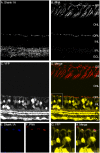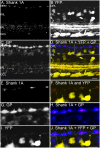Association of shank 1A scaffolding protein with cone photoreceptor terminals in the mammalian retina
- PMID: 22984429
- PMCID: PMC3440378
- DOI: 10.1371/journal.pone.0043463
Association of shank 1A scaffolding protein with cone photoreceptor terminals in the mammalian retina
Abstract
Photoreceptor terminals contain post-synaptic density (PSD) proteins e.g., PSD-95/PSD-93, but their role at photoreceptor synapses is not known. PSDs are generally restricted to post-synaptic boutons in central neurons and form scaffolding with multiple proteins that have structural and functional roles in neuronal signaling. The Shank family of proteins (Shank 1-3) functions as putative anchoring proteins for PSDs and is involved in the organization of cytoskeletal/signaling complexes in neurons. Specifically, Shank 1 is restricted to neurons and interacts with both receptors and signaling molecules at central neurons to regulate plasticity. However, it is not known whether Shank 1 is expressed at photoreceptor terminals. In this study we have investigated Shank 1A localization in the outer retina at photoreceptor terminals. We find that Shank 1A is expressed presynaptically in cone pedicles, but not rod spherules, and it is absent from mice in which the Shank 1 gene is deleted. Shank 1A co-localizes with PSD-95, peanut agglutinin, a marker of cone terminals, and glycogen phosphorylase, a cone specific marker. These findings provide convincing evidence for Shank 1A expression in both the inner and outer plexiform layers, and indicate a potential role for PSD-95/Shank 1 complexes at cone synapses in the outer retina.
Conflict of interest statement
Figures







References
Publication types
MeSH terms
Substances
Grants and funding
LinkOut - more resources
Full Text Sources
Molecular Biology Databases

